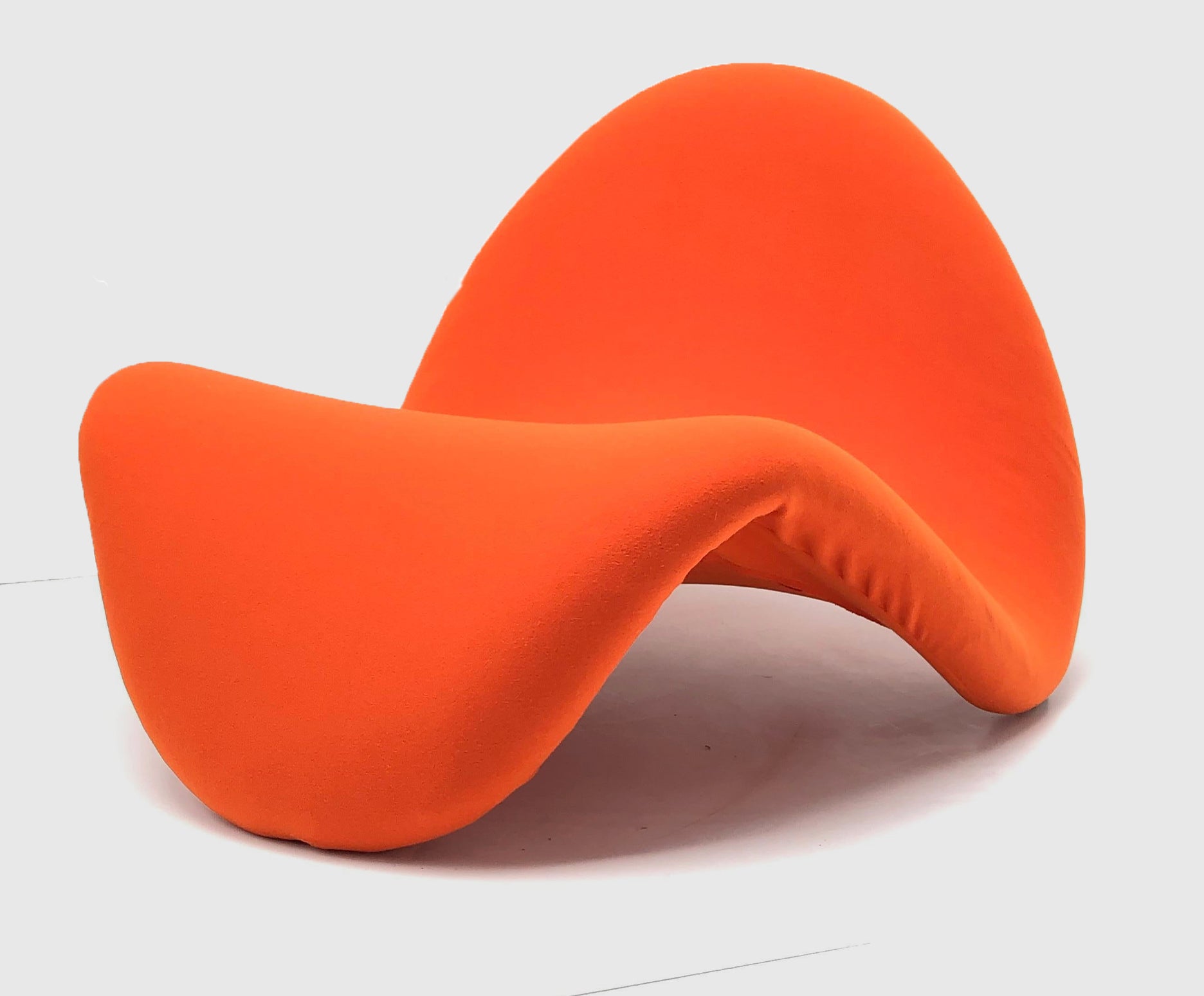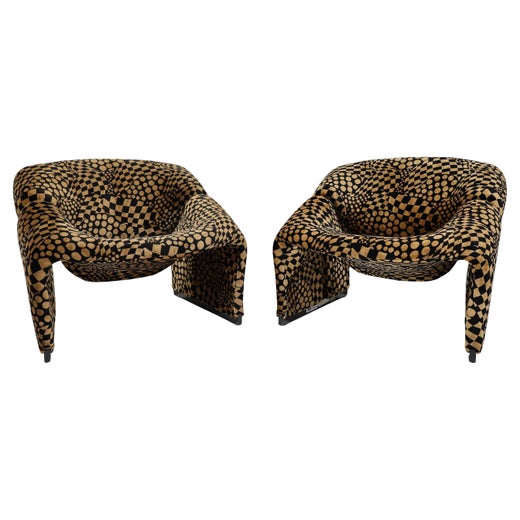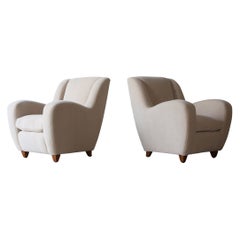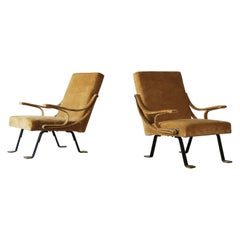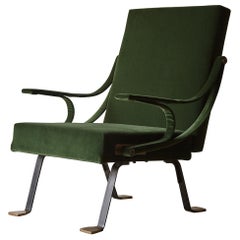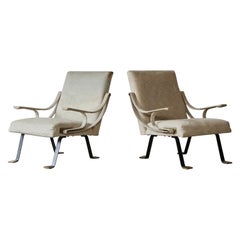Pierre Paulin First Edition Tongue Chair, 1960s
About the Item
- Creator:Pierre Paulin (Designer),Artifort (Maker)
- Design:
- Dimensions:Height: 24.41 in (62 cm)Width: 34.65 in (88 cm)Depth: 35.44 in (90 cm)Seat Height: 14.18 in (36 cm)
- Style:Mid-Century Modern (Of the Period)
- Materials and Techniques:
- Place of Origin:
- Period:
- Date of Manufacture:1960s
- Condition:Reupholstered. Wear consistent with age and use. Very good condition. New upholstery. Ready to use.
- Seller Location:Lewes, GB
- Reference Number:1stDibs: LU2259329120672
Tongue Chair
It’s true — the colorful, sinuous Tongue chair looks just like its namesake. The Tongue’s designer, Pierre Paulin (1927–2009), had a knack for envisioning quirky sculptural chairs, like his Orange Slice chair (1960) and Ribbon chair (1966). Born in Paris, Paulin grew up under the influence of his uncle, automobile designer Georges Paulin, who invented the first mechanical retractable hardtop convertible. Design, it would seem, was in his blood.
After Paulin failed to meet the French national academic qualifications to attend school at the university level, he pursued ceramics and stone carving but ultimately enrolled in the École Camondo in Paris and then went on to work for the Gascoin Company in Le Havre. His interest in nontraditional chairs became apparent in 1954 while he was working for Thonet — there, he began to experiment with stretching swimwear over chair frames. But his creativity peaked in his collaborations with Dutch manufacturer Artifort. In 1960, he designed his first project for the brand: his signature Mushroom lounge chair, a round armchair blanketed in a single piece of fabric that Paulin stretched over its entire frame.
“I considered the manufacture of chairs to be rather primitive, and I was trying to think up new processes,” Paulin recalled in a 2008 interview. “At Artifort, I started using new foam and rubber from Italy and a light metallic frame, combined with ‘stretch’ material.”
The designer wanted to appeal to the antiestablishment, Pop Art–inspired lifestyle of young people, creating chairs with comfortable, low-slung shapes in bold colors. Crafted from a metal frame enshrouded in foam padding and elastic fabric, the 1967 Tongue chair epitomizes that goal with its evocative, legless form that keeps its occupant lounging near the ground, a vast departure from formal chairs that require good posture.
Paulin expanded his repertoire far beyond chairs, designing the Denon Wing of the Louvre and decorating French President Georges Pompidou’s apartment in the Élysée Palace, both in Paris. But his legacy with chairs remains strong. Today, Artifort still manufactures Paulin’s Tongue chair, and, in fact, it continues to produce a number of the designer’s works from the 1960s and 1970s, many of which have been incorporated into the permanent collections of art and design museums around the world.
Pierre Paulin
Pierre Paulin introduced a fresh breeze into French furniture design in the 1960s and ’70s, fostering a sleek new Space-Age aesthetic. Along with Olivier Mourgue, Paulin developed chairs, sofas, dining tables and other furnishings with flowing lines and almost surreal naturalistic forms. And his work became such a byword for chic, forward-looking design and emerging technologies that two French presidents commissioned him to create environments in the Élysée Palace in Paris.
Paulin was born in Paris to a family of artists and designers. He initially sought to become a ceramist and sculptor and was studying in the town of Vallauris near the Côte d'Azur — a center for pottery making, where Pablo Picasso spent his postwar summers crafting ceramics — but broke his hand in a fight. He enrolled at the École Camondo, the Paris interior design school. There, Paulin was strongly influenced by the work of Charles and Ray Eames, George Nelson and Arne Jacobsen, as was reflected in his early creations for the manufacturer Thonet-France.
It was at the Dutch firm Artifort, which he joined in 1958, where Paulin blossomed. In a few years, he produced several of his signature designs based on abstract organic shapes. These include the Butterfly chair (1963), which features a tubular steel frame and slung leather, and a group of striking seating pieces made with steel frames covered in polyurethane foam and tight jersey fabric: the Mushroom (1960), Ribbon (1966) and Tongue (1967) chairs. The revered designer not only introduced new construction techniques to Artifort furniture but contributed fresh materials, Pop art colors and dazzling shapes to the mid-century modern era as a whole.
In 1971, the Mobilier National — a department of France’s Ministry of Culture in charge of furnishing top-tier government offices and embassies — commissioned Paulin to redesign President Georges Pompidou’s private apartment in the Élysée Palace. In three years, Paulin transformed the staid rooms into futuristic environments with curved, fabric-clad walls and furnishings such as bookcases made from an arrangement of smoked-glass U shapes, flower-like pedestal chairs and pumpkin-esque loungers.
Ten years later, the Mobilier National called on Paulin again, this time to furnish the private office of President François Mitterand. Paulin responded with an angular, postmodern take on neoclassical furniture, pieces that looked surprisingly at home in the paneled, Savonnerie-carpeted Louis XVI rooms. As those two Élysée Palace projects show, Paulin furniture works well both in a total decor or when used as a counterpoint to traditional pieces. His creations have a unique personality: bright and playful yet sophisticated and suave.
Find vintage Pierre Paulin lounge chairs, armchairs, coffee tables and other furniture on 1stDibs.
You May Also Like
Vintage 1960s Dutch Mid-Century Modern Lounge Chairs
Fabric
Vintage 1980s Dutch Mid-Century Modern Lounge Chairs
Fabric
Vintage 1960s Dutch Mid-Century Modern Armchairs
Metal
Vintage 1960s Dutch Mid-Century Modern Armchairs
Fabric
Vintage 1960s Dutch Mid-Century Modern Armchairs
Fabric
Vintage 1960s Dutch Mid-Century Modern Armchairs
Fabric
Vintage 1960s Dutch Mid-Century Modern Armchairs
Fabric
Vintage 1960s Dutch Mid-Century Modern Armchairs
Fabric
Vintage 1960s French Mid-Century Modern Lounge Chairs
Steel, Nickel
Vintage 1960s Dutch Mid-Century Modern Lounge Chairs
Fabric, Foam
More From This Seller
View AllMid-20th Century Italian Mid-Century Modern Lounge Chairs
Alpaca, Wood
Mid-20th Century Italian Mid-Century Modern Lounge Chairs
Brass, Steel
Mid-20th Century Italian Mid-Century Modern Lounge Chairs
Brass, Steel
Mid-20th Century Italian Mid-Century Modern Lounge Chairs
Brass, Steel
Mid-20th Century French Mid-Century Modern Lounge Chairs
Fabric, Oak
Mid-20th Century Italian Mid-Century Modern Lounge Chairs
Fabric, Bamboo
Recently Viewed
View AllRead More
At Château La Coste, Pierre Paulin’s Visionary Home Concept Finally Comes to Life
Now synonymous with 1960s and ’70s French chic, the designer conceived his modular modernist furnishings to change the way we decorate.
Exploring Our Current Obsession with Sixties Style
A new exhibition in Philadelphia stars a complex decade that continues to inspire.
